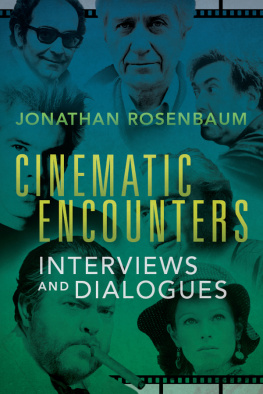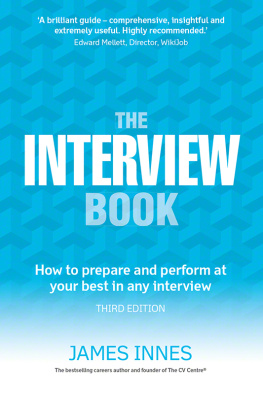JONATHAN ROSENBAUM was the film critic for the Chicago Reader from 1987 to 2008. He is the coauthor of Abbas Kiarostami: Expanded Second Edition and the author of Goodbye Cinema, Hello Cinephilia and Discovering Orson Welles. He archives his work at jonathanrosenbaum.net.
The University of Illinois Press
is a founding member of the
Association of American University Presses.
______________________________
University of Illinois Press
1325 South Oak Street
Champaign, IL 618206903
www.press.uillinois.edu
CHAPTER 1
The Voice and the Eye
A Commentary on the Heart of Darkness Script
Writing an article about Orson Welles's first feature film project while I was living in Paris, I discovered that Welles was currently editing a film there. After acquiring the address of his editing facility, I wrote him a short letter asking a few questions, mostly about the casting, and sent it off on a Saturday afternoon. Not really expecting an answer, I finished a draft of the article by staying up Sunday night and finally going to sleep around 7 A.M. Two hours later, my phone rang, and a man describing himself as a Welles assistant asked me if I could meet his boss for lunch at noon at La Mediterranee, a seafood restaurant only a short hop away from my flat on Rue Mazarine. Given my sleep deprivation, as well as my giddy sense of panic about this opportunity, I decided not to bring along a tape recorder and to simply take a few notes. My first words to Welles (who arrived only a few minutes late, with an apology) conveyed my amazement at the generosity of his invitation. He replied, by way of explanation, that he was too busy to answer my letter. I also owe a clear debt of gratitude to the efficiency of the French postal system at the time.

EARLY LAST JULY, a week before the completion of this article, I had the unexpected privilege of meeting Welles for lunch in Paris, where he was busy editing a new film entitled Hoax, which has something to do with the Clifford Irving/Howard Hughes scandal. (Not a documentary, Welles assured me, but a new kind of a filmalthough he didn't elaborate.) As other commentators have observed, the search for the truth about any Welles project is an endless trip through a labyrinth; possibly no other living director has been the subject of so many conflicting accounts, in large matters as well as small ones. To clarify my sources, all the information given to me by Welles is either stated explicitly or indicated by an asterisk. Unless otherwise noted, the remaining facts about the Heart of Darkness project come from either Richard Wilson or the script itself. (The interpretations, needless to say, are all my own.) Wilson, who was with Welles in Hollywood for most of this period, has generously supplied me with material from the early WellesMercury files. I am also indebted to Carlos Clarens for lending me his copy of the script.
I: The Voice
I became aware that that was exactly what I had been looking forward toa talk with Kurtz. The man presented himself as a voice. The point was in his being a gifted creature, and that of all his gifts the one that stood out pre-eminently, that carried with it a sense of real presence, was his ability to talk, his words
Marlow in Conrad's Heart of Darkness
Appropriately, Orson Welles's first Hollywood project begins as a primal initiation: his voice in darkness, followed by an iris opening out into a bird cage. [2018 note: This alludes to the scripted prologuea text originally included with this article and available now at jonathanrosenbaum.net/1972/11/41656/ and in my book Discovering Orson Welles.] With a master magician's instinct, he leads us directly from estrangement to entrapmentcarrying us in the space of seconds from radio into cinema.
The revised estimating script, from which the preceding introduction is taken, runs to 184 pages and is dated November 30, 1939. Although no author is listed on the title page, it is clear from the existing evidence that it was written and adapted by Welles alone.weak, and except for the parts that came from Conrad, its influence on the screenplay was minimal. Without the availability of Koch's script, this cannot be verified.
The central drama of Heart of Darkness revolves around the myth of virtually unlimited power, achieved by Kurtz, an ivory agent, in the depths of the Congo, where he becomes a god to the natives. The story is narrated by Marlow, a skipper hired by the ivory company, and the plot mainly consists of his long journey down the river toward Kurtz. As with the central character of The Great Gatsby, our total sense of Kurtz comes to us filtered through the narrator's consciousness; he looms in the story as a mysterious figure of rumor and conjecture, and his meaning becomes the sum of everything that Marlow sees and experiences on his way into the jungle. In Conrad's novella, the actual appearance of Kurtz is somewhat anticlimactic, and is handled rather elliptically; in Welles's script, it becomes the dramatic climax that all the preceding action builds up to.
Welles said that he originally planned to play only the part of Marlow, hoping he could find someone else for the part of Kurtz. By the time the final estimating script had been written, however, he had decided to take on both parts. As a penetration into the mystery of a powerful, legendary man, Heart of Darkness clearly prefigures Citizen Kane; exploring the tension between Marlow and Kurtz, Welles was obviously interested in expressing the same sort of ambivalence about power and position that informs his later films. To make this concern more personal and immediate, he updated Conrad's story to the present, made Marlow into an American, and explicitly linked Kurtz's despotism to the tyranny sweeping over Europe in the late thirties and early forties. As Marlow, he would figure primarily as Narrative Voice and unseen hero, glimpsed only occasionally as a reflection or, between episodes, back on his boat in the New York harbor, telling the story. As Kurtz, he would also remain offscreen for most of the film, but then make a grand demonic appearance at the climax.
Welles deliberately pointed up the doppelgnger aspect of this dual role by frequently drawing attention in the dialogue to the physical resemblance between Marlow and Kurtz; expanding the part of Kurtz's unnamed fiance into a full-fledged heroine named Elsa,that spectator = Marlow = Kurtz = Welles = dictatora notion that is at once so abstract and so audacious that, coupled with a million-dollar budget, eighty-two-day shooting schedule, and the outbreak of World War II, it is hardly surprising that RKO shelved the project. Welles told me he later learned the primary resistance came not from George Schaeferthe president of RKO, who'd brought him to Hollywoodbut from the other studio heads.
The roots of the script can be traced through much of Welles's theater and radio work in the late thirties. In 1936, he had already conjured up a sinister atmosphere of jungle tribalism in his voodoo stage production of Macbeth, set in Haiti with an all-black cast. The following year, he played the title role in his staging of Dr. Faustusa character who quite likely contributed to his conception of Kurtzand then played Brutus in his modern-dress Julius Caesar, which was particularly noted at the time for its contemporary political parallels (fascist-style uniforms and salutes, Nuremberg lighting, etc.). But the importance of his radio work was probably even more decisive. The first Mercury radio series, First Person Singular, broadcast eight programs in the summer of 1938 and introduced a narrative technique that was, at the time, completely new to the medium.
Next page














